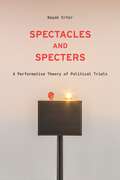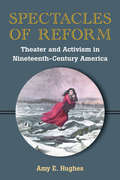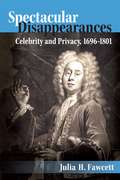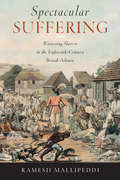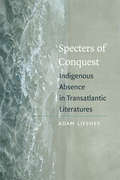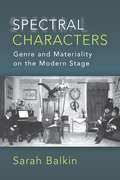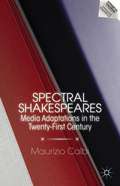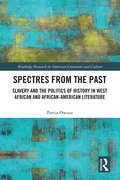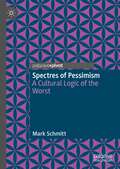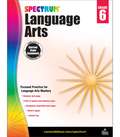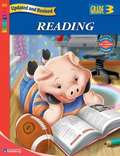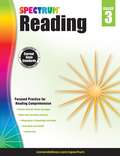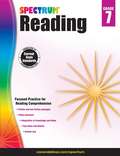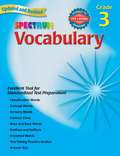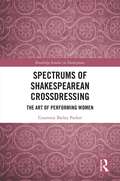- Table View
- List View
Spectacles and Specters: A Performative Theory of Political Trials
by Başak ErtürWINNER, SLSA SOCIO-LEGAL THEORY AND HISTORY PRIZESHORTLISTED, THE HART-SLSA BOOK PRIZESpectacles and Specters draws on theories of performativity to conceptualize the entanglements of law and political violence, offering a radical departure from accounts that consider political trials as instrumental in exercising or containing political violence. Legal scholar Başak Ertür argues instead that making sense of the often incalculable interpenetrations of law, politics, and violence in trials requires shifting the focus away from law’s instrumentality to its performativity.Ertür develops a theory of political trials by reconstructing and building on a legacy of critical thought on Nuremberg in close engagement with theories of performativity. She then offers original case studies that introduce a new perspective by looking beyond the Holocaust trials, to the Armenian genocide and its fragmentary legal aftermaths. These cases include the 1921 trial of Soghomon Tehlirian, the 2007-21 Hrant Dink Murder Trial, and the 2015 case before the European Court of Human Rights concerning the denial of the Armenian genocide. Enabling us to capture the various modalities in which the political emerges in, through and in relation to legal forms on the stage of the trial, this focus on law’s performativity also allows us to account for how sovereign schemes can misfire and how trials can come to have unintended political lives and afterlives. Further, it reveals how law is entangled with and perpetuates certain histories of violence, rather than simply ever mastering these histories or providing closure.
Spectacles of Reform: Theater and Activism in Nineteenth-Century America
by Hughes Amy E.In the nineteenth century, long before film and television arrived to electrify audiences with explosions, car chases, and narrow escapes, it was America's theaters that offered audiences such thrills, with "sensation scenes" of speeding trains, burning buildings, and endangered bodies, often in melodramas extolling the virtues of temperance, abolition, and women's suffrage. In Spectacles of Reform , Amy E. Hughes scrutinizes these peculiar intersections of spectacle and reform, revealing that spectacle plays a crucial role in American activism. By examining how theater producers and political groups harnessed its power and appeal, Hughes suggests that spectacle was—and remains—central to the dramaturgy of reform. Engaging evidence from lithographs to children's books to typography catalogs, Hughes traces the cultural history of three famous sensation scenes—the drunkard suffering from the delirium tremens, the fugitive slave escaping over a river, and the victim tied to the railroad tracks—assessing how they conveyed, allayed, and denied concerns about the rights and responsibilities of citizenship. These images also appeared in printed propaganda, suggesting that the coup de théâtre was an essential part of American reform culture. Additionally, Hughes argues that today's producers and advertisers continue to exploit the affective dynamism of spectacle, reaching an even broader audience through film, television, and the Internet. To be attuned to the dynamics of spectacle, Hughes argues, is to understand how we see. Consequently, Spectacles of Reform will interest not only theater historians, but also scholars and students of political, literary, and visual culture who are curious about how U. S. citizens saw themselves and their world during a pivotal period in American history.
Spectacular Disappearances: Celebrity and Privacy, 1696-1801
by Julia H. FawcettHow can people in the spotlight control their self-representations when the whole world seems to be watching? The question is familiar, but not new. Julia Fawcett examines the stages, pages, and streets of eighteenth-century London as England's first modern celebrities performed their own strange and spectacular self-representations. They include the enormous wig that actor Colley Cibber donned in his comic role as Lord Foppington-and that later reappeared on the head of Cibber's cross-dressing daughter, Charlotte Charke. They include the black page of Tristram Shandy, a memorial to the parson Yorick (and author Laurence Sterne), a page so full of ink that it cannot be read. And they include the puffs and prologues that David Garrick used to heighten his publicity while protecting his privacy; the epistolary autobiography, modeled on the sentimental novel, of Garricks protégée George Anne Bellamy; and the elliptical poems and portraits of the poet, actress, and royal courtesan Mary Robinson, a. k. a. Perdita. Linking all of these representations is a quality that Fawcett terms "over-expression," the unique quality that allows celebrities to meet their spectators' demands for disclosure without giving themselves away. Like a spotlight so brilliant it is blinding, these exaggerated but illegible self-representations suggest a new way of understanding some of the key aspects of celebrity culture, both in the eighteenth century and today. They also challenge divides between theatrical character and novelistic character in eighteenth-century studies, or between performance studies and literary studies today. The book provides an indispensable, history for scholars and students in celebrity studies, performance studies, and autobiography-and for anyone curious about the origins of the eighteenth-century self. Book jacket.
Spectacular Suffering: Witnessing Slavery in the Eighteenth-Century British Atlantic
by Ramesh MallipeddiSpectacular Suffering focuses on commodification and discipline, two key dimensions of Atlantic slavery through which black bodies were turned into things in the marketplace and persons into property on plantations. Mallipeddi approaches the problem of slavery as a problem of embodiment in this nuanced account of how melancholy sentiment mediated colonial relations between English citizens and Caribbean slaves.The book’s first chapters consider how slave distress emerged as a topic of emotional concern and political intervention in the writings of Aphra Behn, Richard Steele, and Laurence Sterne. As Mallipeddi shows, sentimentalism allowed metropolitan authors to fashion themselves as melancholy witnesses to racial slavery by counterposing the singular body to the abstract commodity and by taking affective property in slaves against the legal proprietorship of slaveholders. Spectacular Suffering then turns to the practices of the enslaved, tracing how they contended with the effects of chattel slavery. The author attends not only to the work of African British writers and archival textual materials but also to economic and social activities, including slaves’ petty production, recreational forms, and commemorative rituals. In examining the slaves’ embodied agency, the book moves away from spectacular images of suffering to concentrate on slow, incremental acts of regeneration by the enslaved. One of the foremost contributions of this study is its exploration of the ways in which the ostensible objects of sentimental compassion—African slaves—negotiated the forces of capitalist abstraction and produced a melancholic counterdiscourse on slavery.Throughout, Mallipeddi’s keen reading of primary texts alongside historical and critical work produce fresh and persuasive insights. Spectacular Suffering is an important book that will alter conceptions of slave agency and of sentimentalism across the long eighteenth century.
Specters of Cavafy (Greek / Modern Intersections)
by Maria BoletsiThe Greek Alexandrian poet C. P. Cavafy (1863–1933) has been recognized as a central figure in European modernism and world literature. His poetry explored the conditions for animating the past and making lost worlds or people haunt the present. Yet he also described himself as “a poet of the future generations.” Indeed, his writings address concerns and desires that permeate the twentieth and twenty-first centuries. How does poetry concerned with the past, memory, loss, and death, carry futurity? How does it haunt, and how is it haunted by, future presents? Specters of Cavafy broaches these questions by proposing spectral poetics as a novel approach to Cavafy’s work. Drawing from theorizations of specters and haunting, it develops spectrality as a lens for revisiting Cavafy’s poetry and prose, fiction and nonfiction, as well as his poetry’s bearing on our present. By examining Cavafy’s spectral poetics, the book’s first part shows how conjurations work in his writings, and how the spectral permeates the entanglement of modernity and haunting, and of irony and affect. The second part traces the afterlives of specific poems in the Western imagination since the 1990s, in Egypt’s history of debt and colonization, and in Greece during the country’s recent debt crisis. Beyond its original contribution to Cavafy studies, the book proposes tools and modes of reading that are broadly applicable in literary and cultural studies.
Specters of Conquest: Indigenous Absence in Transatlantic Literatures
by Adam LifsheyThis book intervenes in transatlantic and hemispheric studies by positing "America" as not a particular country or continent but a foundational narrative, in which conquerors arrive at a shore intent on overwriting local versions of humanity, culture, and landscape with inscriptions of their own design. This imposition of foreign textualities, however dominant, is never complete because the absences of the disappeared still linger manifestly, still are present. That apparent paradox results in a haunted America, whose conquest is always partial and whose conquered are always contestatory. Readers of scholarship by transatlanticists such as Paul Gilroy and hemispherists such as Diana Taylor will find new conceptualizations here of an America that knows no geographic boundaries, whose absences are collective but not necessarily interrelated by genealogy. The five principal texts at hand - Columbus's diary of his first voyage, the Popol Vuh of the Maya-K'iche', Defoe's Robinson Crusoe, Evita's Cuando los Combes luchaban (the first African novel in Spanish), and Pynchon's Mason & Dixon - are examined as foundational stories of America in their imaginings of its transatlantic commencement. Interspersed too are shorter studies of narratives by William Carlos Williams, Rigoberta Menchú, Álvar Núñez Cabeza de Vaca, José Martí, Mark Knopfler (former lead singer of Dire Straits) and Gabriel García Márquez. These texts are rarely if ever read together because of their discrete provenances in time and place, yet their juxtaposition reveals how the disjunctions and ruptures that took place on the eastern and western shores of the Atlantic upon the arrival of Europeans became insinuated as recurring and resistant absences in narratives ostensibly contextualized by the Conquest.The book concludes by proposing that Mary Shelley's Frankenstein is the great American novel.After Specters of Conquest: Indigenous Absence in Transatlantic Literatures, America will never seem the same.
Specters of the Marvelous: Race and the Development of the European Fairy Tale (The Donald Haase Series in Fairy-Tale Studies)
by Kimberly J. LauA transformative lens revealing the historical racial context that profoundly influenced European fairy tales. In stories retold for generations, wondrous worlds and magnificent characters have defined the genre of European fairy tales with little recognition of yet another defining aspect—racism and racialized thinking. Engaging four classic fairy-tale collections, author Kimberly J. Lau connects close readings of the tales to the cultural discourses, scholarly debates, and imperial geopolitics that established and perpetuated ideas about racial difference and white superiority. Within the tales of Giambattista Basile, Marie-Catherine d'Aulnoy, the Grimms, and Andrew and Nora Lang, Lau teases apart and historicizes the racialized themes and ideologies embedded within fairy tales spanning the early seventeenth to early twentieth centuries. She contends that the European fairy tale is definitively marked, whether implicitly or explicitly, by whiteness, and given the genre's documented colonization of diverse narrative traditions over time, this specter of race is all the more haunting. This trailblazing work demonstrates the continuous evolution of racialized thinking that has informed the publication and dissemination of fairy tales. Here, Lau provides a new framework for understanding European fairy tales in the milieux in which they were created, bringing distant and ethereal worlds back to earth.
Spectral Characters: Genre and Materiality on the Modern Stage
by Sarah BalkinTheater’s materiality and reliance on human actors has traditionally put it at odds with modernist principles of aesthetic autonomy and depersonalization. Spectral Characters argues that modern dramatists in fact emphasized the extent to which humans are fictional, made and changed by costumes, settings, props, and spoken dialogue. Examining work by Ibsen, Wilde, Strindberg, Genet, Kopit, and Beckett, the book takes up the apparent deadness of characters whose selves are made of other people, whose thoughts become exteriorized communication technologies, and whose bodies merge with walls and furniture. The ghostly, vampiric, and telepathic qualities of these characters, Sarah Balkin argues, mark a new relationship between the material and the imaginary in modern theater. By considering characters whose bodies respond to language, whose attempts to realize their individuality collapse into inanimacy, and who sometimes don’t appear at all, the book posits a new genealogy of modernist drama that emphasizes its continuities with nineteenth-century melodrama and realism.
Spectral Nationality: Passages of Freedom from Kant to Postcolonial Literatures of Liberation
by Pheng CheahThis far-ranging and ambitious attempt to rethink postcolonial theory's discussion of the nation and nationalism brings the problems of the postcolonial condition to bear on the philosophy of freedom. Closely identified with totalitarianism and fundamentalism, the nation-state has a tainted history of coercion, ethnic violence, and even, as in ultranationalist Nazi Germany, genocide. Most contemporary theorists are therefore skeptical, if not altogether dismissive, of the idea of the nation and the related metaphor of the political body as an organism. Going against orthodoxy, Pheng Cheah retraces the universal-rationalist foundations and progressive origins of political organicism in the work of Kant and its development in philosophers in the German tradition such as Fichte, Hegel, and Marx. Cheah argues that the widespread association of freedom with the self-generating dynamism of life and culture's power of transcendence is the most important legacy of this tradition. Addressing this legacy's manifestations in Fanon and Cabral's theories of anticolonial struggle and contemporary anticolonial literature, including the Buru Quartet by Indonesian writer Pramoedya Ananta Toer, and the Kenyan writer Ngugi Wa Thiong'o's nationalist novels, Cheah suggests that the profound difficulties of achieving freedom in the postcolonial world indicate the need to reconceptualize freedom in terms of the figure of the specter rather than the living organism.
Spectral Shakespeares
by Maurizio CalbiSpectral Shakespeares is an illuminating exploration of recent, experimental adaptations of Shakespeare on film, TV, and the web. Drawing on adaptation studies and media theory as well as Jacques Derrida's work, this book argues that these adaptations foreground a cluster of self-reflexive "themes" - from incorporation to reiteration, from migration to addiction, from silence to survival - that contribute to the redefinition of adaptation, and Shakespearean adaptation in particular, as an unfinished and interminable process. The "Shakespeare" that emerges from these adaptations is a fragmentary, mediatized, and heterogeneous presence, a spectral Shakespeare that leaves a mark on our contemporary mediascape.
Spectral Spaces and Hauntings: The Affects of Absence (Routledge Research in Cultural and Media Studies)
by Christina LeeThis anthology explores the spatial dimension and politics of haunting. It considers how the ‘appearance’ of absence, emptiness and the imperceptible can indicate an overwhelming presence of something that once was, and still is, (t)here. At its core, the book asks: how and why do certain places haunt us? Drawing from a diversity of mediums, forms and disciplinary approaches, the contributors to Spectral Spaces and Hauntings illustrate the complicated ways absent presences can manifest and be registered. The case studies range from the memory sites of a terrorist attack, the lost home, a vanished mining town and abandoned airports, to the post-apocalyptic wastelands in literary fiction, the photographic and filmic surfaces where spectres materialise, and the body as a site for re-corporealising the disappeared and dead. In ruminating on the afteraffects of spectral spaces on human experience, the anthology importantly foregrounds the ethical and political imperative of engaging with ghosts and following their traces.
Spectres from the Past: Slavery and the Politics of "History" in West African and African-American Literature (Routledge Research in American Literature and Culture)
by Portia OwusuSpectres from the Past: The "History" of Slavery in West African and African-American Narratives examines the merit of the claim that West African writers, in comparison to African-Americans authors, deliberately expunge the history of slavery from literary narratives. The book explores slavery in contemporary West African and African-American literature by looking at the politics of history and memory. It interrogates notions of History and memory by considering the possibility that shared traumas, such as West African and African-American experiences of slavery, can be remembered and historicised differently, according to critical factors such as socio-economic realities, cultural beliefs and familial traditions. At the heart of the book are compelling and new readings of slavery in six literary narratives that draws on cultural philosophies, musicology and linguistics to demonstrate diverse and unusual ways that Black writers in West Africa and North America write about slavery in literature.
Spectres of Pessimism: A Cultural Logic of the Worst
by Mark SchmittThis book argues that philosophical pessimism can offer vital impulses for contemporary cultural studies. Pessimist thought offers ways to interrogate notions of temporality, progress and futurity. When the horizon of future expectation is increasingly shaped by the prospect of apocalypse and extinction, an exploration of pessimist thought can help to make sense of an increasingly complex and uncertain world by affirming rather than suppressing the worst. This book argues that a cultural logic of the worst is at work in a substantial section of contemporary philosophical thought and cultural representations.Spectres of pessimism can be found in contemporary ecocritical thought, antinatalist philosophies, political thought, and cultural theory, as well as in literature, film, and popular music. In its unsettling of temporality, this new pessimism shares sensibilities with the field of hauntology. Both deconstruct linear narratives of time that adhere to a stable sequence of past, present and future. Mark Schmitt therefore couples pessimism and hauntology to explore the spectres of pessimism in a range of theories and narratives—from ecocriticism, antinatalism and queer theory to utopianism, from afropessimism to the fiction of Hari Kunzru and Thomas Ligotti to the films of Camille Griffin, Gaspar Noé, Denis Villeneuve and Lars von Trier.
Spectrum Language Arts (Grade #4)
by SpectrumAn understanding of language arts concepts is key to strong communication skills―the foundation of success across disciplines. Spectrum Language Arts for grade 4 provides focused practice and creative activities to help your child master grammar, vocabulary, parts of speech, and sentence types.<p><p> This comprehensive workbook doesn’t stop with focused practice–it encourages children to explore their creative sides by challenging them with thought-provoking writing projects. Aligned to current state standards, Spectrum Language Arts for grade 4 includes an answer key and a supplemental Writer’s Guide to reinforce grammar and language arts concepts. With the help of Spectrum, your child will build the language arts skills necessary for a lifetime of success.
Spectrum Language Arts, Grade 6 (Spectrum Series)
by SpectrumAn understanding of language arts concepts is key to strong communication skills the foundation of success across disciplines. Spectrum Language Arts for grade 5 provides focused practice and creative activities to help your child master sentence types, parts of speech, vocabulary, and grammar. <P><P>—This comprehensive workbook doesnt stop with focused practice it encourages children to explore their creative sides by challenging them with thought-provoking writing projects. <P><P>Aligned to current state standards, Spectrum Language Arts for grade 5 includes an answer key and a supplemental Writers Guide to reinforce grammar and language arts concepts. With the help of Spectrum, your child will build the language arts skills necessary for a lifetime of success.
Spectrum Reading
by School Specialty PublishingReading skills include: Author’s purpose, Synonyms and antonyms, Reading comprehension, Phonics skills, Study skills.
Spectrum Reading (Spectrum Series)
by SpectrumThe Spectrum® Reading Workbook for Grade 2 features 174 pages of illustrated fiction, informational texts, and engaging exercises that strengthen students’ ability to understand, process, and analyze text. This standards-based workbook enhances reading comprehension skills with grade-appropriate, yet challenging reading passages and discussion questions. <p><p>This focused, repetitive practice is essential to boosting reading and language arts skills. Concepts include letters and sounds, word recognition, integration of knowledge and ideas, key ideas and details, main idea, story structure, theme, and summarization. An answer key is included to help parents and teachers accurately monitor students’ progress and feel confident in their competency. The best-selling Spectrum series is a favorite of parents and teachers because it's carefully designed to be both effective and engaging––the perfect building blocks for a lifetime of learning.
Spectrum Reading Grade 3
by SpectrumSpectrum Reading will help your child improve their reading habits and strengthen their ability to understand and analyze text.
Spectrum Reading, Grade 4
by SpectrumStrong reading skills are the basis of school success, and Spectrum Reading for grade 4 will help children triumph over language arts and beyond. This standards-based workbook uses engaging text to support understanding theme, summarization, knowledge integration, key ideas, and details. <p><p> Spectrum Reading will help your child improve their reading habits and strengthen their ability to understand and analyze text. This best-selling series is a favorite of parents and teachers because it is carefully designed to be both effective and engaging the perfect building blocks for a lifetime of
Spectrum Reading, Grade 7
by SpectrumSpectrum Reading for Grade 7 includes focused practice for reading comprehension including fiction and non-fiction passages, story structure, integration of knowledge and ideas, and key ideas and details. Spectrum(R) Reading workbooks contain focused practice for reading comprehension, including letters and sounds, word recognition, integration of knowledge and ideas, key ideas and details, main idea, story structure, theme, and summarization. Each lesson features an illustrated story followed by exercise in comprehension. A variety of fiction and nonfiction reading passages combined with standards-based learning make these workbooks an essential resource for school success. A complete answer key is included. Spectrum, the best-selling workbook series, is proud to provide quality, educational materials that support your students' learning achievement and success.
Spectrum Spelling, Grade 1
by SRA/McGraw-HillThis series links spelling to reading and writing. It increases skills in words and meanings, consonant and vowel spelling, and proofreading practice. Riddles, brainteasers, and puzzles make spelling fun. Includes a speller dictionary and an answer key.
Spectrum Test Prep, Grade 3
by Spectrum StaffSpectrum(R) Test Prep Grade 3 includes strategy-based activities for language arts and math, test tips to help answer questions, and critical thinking and reasoning. The Spectrum(R) Test Prep series for grades 1 to 8 was developed by experts in education and was created to help students improve and strengthen their test-taking skills. The activities in each book not only feature essential practice in reading, math, and language arts test areas, but also prepare students to take standardized tests. Students learn how to follow directions, understand different test formats, use effective strategies to avoid common mistakes, and budget their time wisely. Step-by-step solutions in the answer key are included. These comprehensive workbooks are an excellent resource for developing skills for assessment success. Spectrum(R), the best-selling workbook series, is proud to provide quality educational materials that support your students’ learning achievement and success.
Spectrum Vocabulary, Grade 3
by Carson-Dellosa Publishing Staff Spectrum StaffSpectrum Vocabulary makes word analysis and vocabulary building easier than ever! The lessons, perfect for students in third grade, strengthen phonics skills by focusing on concept and sensory words, context clues, imported words, and more! Each book aids with classification, context, sensory, concept, and word structure strategies. They are also aligned to national and state standards and include a complete answer key. --Today, more than ever, students need to be equipped with the essential skills they need for school achievement and for success on proficiency tests. The Spectrum series has been designed to prepare students with these skills and to enhance student achievement. Developed by experts in the field of education, each title in the Spectrum workbook series offers grade-appropriate instruction and reinforcement in an effective sequence for learning success. Perfect for use at home or in school, and a favorite of parents, homeschoolers, and teachers worldwide, Spectrum is the learning partner students need for complete achievement.
Spectrum of Decadence: The Literature of the 1890s (Routledge Revivals)
by Murray PittockThe 1890s, the Naughty Nineties, was an exciting and flamboyant time in British life and literature. First published in 1993, this title traces the genesis of the literary culture of the 1890s through some of the popular novels and literary texts of the period. By examining works by such writers as Oscar Wilde, Bram Stoker, W. B. Yeats, and Walter Pater, Murray Pittock analyses the nature of the ‘Decadent era’ and the artistic theories of Symbolism and Aestheticism. Significantly, he provides a full assessment of the lasting impact that the thought of the period has had on our own understanding of our cultural past. Spectrum of Decadence explores the confrontations between art and science, sex and mortality, desire and virtue, which, the author argues are as much a part of modern society’s fin-de-siécle as they were of the nineteenth century’s. This reissue bridges the gap between literary texts, historical context, and contemporary critical theory.
Spectrums of Shakespearean Crossdressing: The Art of Performing Women (Routledge Studies in Shakespeare)
by Courtney Bailey ParkerSince young male players were the norm during the English Renaissance, were all cross-dressed performances of female characters played with the same degree of seriousness? Probably not. Spectrums of Representation in Shakespearean Crossdressing examines these varied types of female characters in English Renaissance drama, drawing from a range of play texts themselves in order to investigate if evidence exists for varying performance practices for male-to-female crossdressing. This book argues for a reading of the representation of female characters on the English Renaissance stage that not only suggests categorizing crossdressing along a spectrum of theatrical artifice, but also explores how this range of artifice enriches our understanding of the plays. The scholarship surrounding cross-dressing rarely makes this distinction, since in our study of early modern plays we tend to accept as a matter of course that all crossdressing was essentially the same. The basis of Spectrums of Representation in Shakespearean Crossdressing is that it was not.
